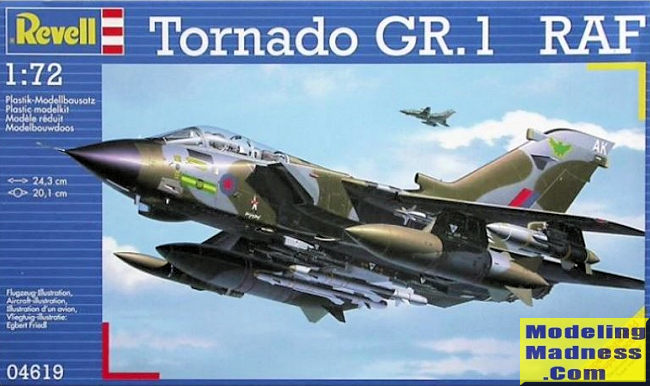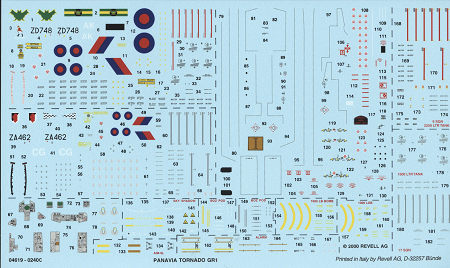
Revell 1/72 Tornado GR.1
| KIT #: | 04619 |
| PRICE: | $ |
| DECALS: | Two option |
| REVIEWER: | Scott Van Aken |
| NOTES: | 2000 boxing |

| HISTORY |
The Panavia Tornado is a jet engine fighter-bomber jointly developed as the Multi-role combat aircraft - or MRCA - by Italy, Germany and the United Kingdom. It first flew on August 14th, 1974. International co-operation continued after its entry into service within the Tri-National Tornado Training Establishment, a tri-nation training and evaluation unit operating from RAF Cottesmore in Rutland in the English Midlands. 992 aircraft (all variants) were built for the three partner nations and Saudi Arabia.
The Tornado IDS is operated by Germany, Italy, Saudi Arabia and the United Kingdom. It is one of the world's most sophisticated and capable interdiction and attack aircraft, with large payload, long range and high survivability.
The Tornado was cleared to carry almost all the air-launched weapons in the NATO inventory, including cluster bombs, anti-runway munitions, and nuclear weapons. Known as the Tornado GR4 in the RAF, which is an upgrade of the original Tornado GR1 featuring GPS navigation and the ability to deploy more advanced munitions.
A major feature of the GR1 was its terrain-following radar, which allowed all-weather hands-off low-level flight, but current doctrine eschews extreme low-level flight and relies on inertial navigation with GPS updates rather than TFS. The GR1A was a reconnaissance variant equipped with the internally mounted TIRRS (Tornado Infra-Red Reconnaissance System) replacing the 27 mm cannon. GR1B was a maritime strike aircraft brought into service to replace the Blackburn Buccaneer and deliver the Sea Eagle anti-ship missile. The aircraft could only track targets via the missile's radar seeker. The reconnaissance variant of the GR4 is the GR4A.
The GR1 was delivered in a grey/green camouflage, but this was changed to dark grey during the late 1990s. In operations over Iraq some GR1s received a sandy "pink" scheme. GR4s participating in the 2003 Iraq War were painted in a light grey scheme. German Navy examples normally sport a distinctive black/blue/grey camouflage pattern.
The UK is researching possible replacements under the Future Offensive Air System study, which could be a piloted aircraft, a UAV or a cruise missile-based system. Currently no other aircraft (in service or planned) matches the Tornado's strike capabilities. The type's retirement in 2019 has left the RAF with little to offer in terms of dedicated strike aircraft. While its planned replacement is the F-35, it is slow to enter service and cannot carry the sort of loads the Tornado could, leaving many to think that the Tornado's retirement was premature.
| THE KIT |
It was recommended to me, after doing the Hasegawa GR.1 preview, that I get the Revell kit and compare the two after I'd built them. This seemed like a good idea so I ordered one from the UK. Due to the type of 'wraparound' packaging that seems to be in vogue in Europe, the rather smushed box arrived about two weeks after ordering it. The kit inside was undamaged as the box is fairly fully packed with sprues. Detailing is typical of what RoG was producing when this kit was released in 2000.
The fuselage is divided into forward and aft sections with the forward section split vertically and the aft portion split horizontally. This is to handle the working swing wings. The cockpit tub incorporates two four-piece seats, two instrument panels and the controls for the pilot and weapons system operator. Decals are provided for the panels if you so wish to use them. Cockpit sits atop the nose gear well when closing the fuselage halves. Note that there are holes for the refueling probe that will need to be opened. You also need to find room for 10 grams of weight to prevent tail sitting but there seems to be sufficient space.
Unlike the ADV kit which used a heated screwdriver to melt the wing pylons in place, this one uses small plastic C clips. You still need heat for the connection between the tailplanes, though. The wing mechanism is held in place by joining the upper and lower aft fuselage halves. Fixing the fuselage seam around the tailplanes will not be all that easy with the parts in place so care is needed.
The fin is in two halves and fits into a channel in the upper fuselage. The nose sections is attached prior to building up and attaching the intakes. There is no intake trunking with the open intakes simply going into the aft fuselage. Contest modelers will need to form blanking plates. At the back are optional open or closed speed brakes. I should mention that the exhaust section can only be built with the thrust reversers in the closed position.
Landing gear is well done and fits into somewhat generic wells. The gear doors are all molded closed so will have to be cut to model the plane on the ground. Typical of modern jets, there are a lot of antennas and other bumps to attach to the airframe. The undernose seeker should have the clear bit attached after the model has been painted unless you want to mask it. One can pose the air refueling probe extended if one wishes.
Now that you have a fairly complete model one builds
up and attaches the belly pylons and the missile pylons to the
 inner wing
pylons. For wing tanks you have a pair of 1500 liter ones or the 2250 'Hindenberger
tanks. A Skyshadow and BOZ 101 pod are provided for the outer pylons with
Sidewinders for the missile rails. Four 1,000lb bombs are supplied for the
fuselage racks. Or you can install Laser bombs or even a pair of ALARM missiles.
Load-out diagrams are provided.
inner wing
pylons. For wing tanks you have a pair of 1500 liter ones or the 2250 'Hindenberger
tanks. A Skyshadow and BOZ 101 pod are provided for the outer pylons with
Sidewinders for the missile rails. Four 1,000lb bombs are supplied for the
fuselage racks. Or you can install Laser bombs or even a pair of ALARM missiles.
Load-out diagrams are provided.
Instructions are typical Revell with only Revell paint numbers provided, which will require some mixing of shades. A huge decal sheet is provided that is mostly airframe and weapons stencils. Unique markings are for a 9 Squadron plane at Bruggen in 1998 wearing the standard green/grey wrap camouflage. The other is a 17 Squadron plane in a dark sea grey over dark camouflage grey camouflage scheme also at Bruggen in 1998.
| CONCLUSIONS |
I am thinking that this kit is the newest of all the 1/72 Tornado GR.1 kits. I seriously doubt if any other company will produce one in this scale, especially now that it is out of service with the RAF, but one never knows. It looks to be a somewhat complex, but straight-forward build.
| REFERENCES |
The Wiki Tornado page.
August 2019 Copyright ModelingMadness.com.
All rights reserved If you would like your product reviewed fairly and
fairly quickly, please
contact
the editor or see other details in the
Note to
Contributors.